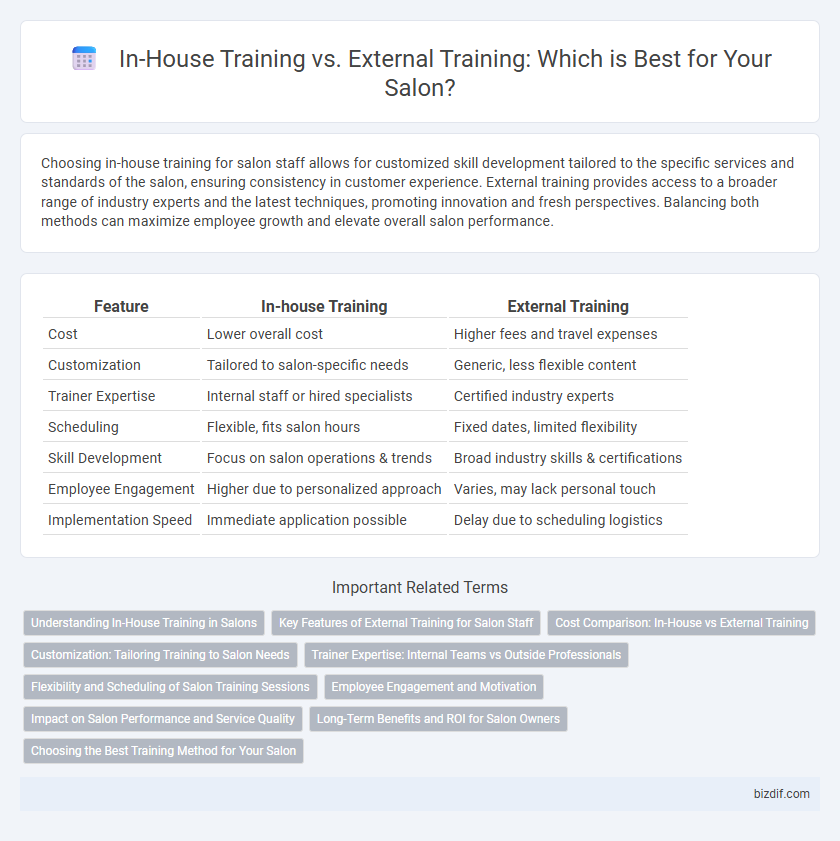Choosing in-house training for salon staff allows for customized skill development tailored to the specific services and standards of the salon, ensuring consistency in customer experience. External training provides access to a broader range of industry experts and the latest techniques, promoting innovation and fresh perspectives. Balancing both methods can maximize employee growth and elevate overall salon performance.
Table of Comparison
| Feature | In-house Training | External Training |
|---|---|---|
| Cost | Lower overall cost | Higher fees and travel expenses |
| Customization | Tailored to salon-specific needs | Generic, less flexible content |
| Trainer Expertise | Internal staff or hired specialists | Certified industry experts |
| Scheduling | Flexible, fits salon hours | Fixed dates, limited flexibility |
| Skill Development | Focus on salon operations & trends | Broad industry skills & certifications |
| Employee Engagement | Higher due to personalized approach | Varies, may lack personal touch |
| Implementation Speed | Immediate application possible | Delay due to scheduling logistics |
Understanding In-House Training in Salons
In-house training in salons provides tailored education directly aligned with the salon's specific services, culture, and client expectations, enhancing stylist proficiency and consistency. This method enables immediate feedback and hands-on practice in a real work environment, fostering skill retention and boosting team morale. Investing in in-house training reduces downtime and travel costs, making it a cost-effective approach for ongoing professional development in the beauty industry.
Key Features of External Training for Salon Staff
External training for salon staff offers access to specialized expertise and the latest industry techniques not always available in-house. It provides diverse learning environments, enhancing creativity and adaptability through exposure to different instructors and peer groups. This approach often includes certification opportunities, boosting staff credibility and client trust.
Cost Comparison: In-House vs External Training
In-house training typically reduces overall expenses by eliminating travel and accommodation costs, while offering customized content tailored to the salon's specific needs. External training often involves higher fees, including registration, transportation, and sometimes equipment, but provides access to expert instructors and industry certifications. Salons must weigh immediate cost savings against long-term benefits when choosing between in-house development and external professional workshops.
Customization: Tailoring Training to Salon Needs
In-house training at salons allows for customized programs that directly address the unique skills, products, and service styles of the establishment, enhancing employee relevance and engagement. External training offers access to industry experts and diverse techniques but may lack the personalized focus needed for specific salon branding and client preferences. Tailoring training to salon needs maximizes staff performance and ensures consistent service standards aligned with the salon's market positioning.
Trainer Expertise: Internal Teams vs Outside Professionals
In-house training leverages internal teams' deep understanding of salon culture and specific operational nuances, ensuring tailored skill development aligned with business goals. External training brings specialized expertise from industry professionals with broad, up-to-date knowledge of trends, advanced techniques, and innovations that internal staff may not possess. Choosing between internal and external trainers depends on the balance between personalized guidance and access to diverse, cutting-edge expertise crucial for salon staff advancement.
Flexibility and Scheduling of Salon Training Sessions
In-house training offers salons unparalleled flexibility, allowing sessions to be scheduled during off-peak hours to minimize client disruption and tailor content to immediate team needs. External training often requires fixed dates and travel, which can limit availability and disrupt salon operations. Prioritizing in-house training enhances scheduling adaptability and ensures consistent skill development aligned with salon goals.
Employee Engagement and Motivation
In-house training in salons fosters higher employee engagement by providing tailored skill development in a familiar environment, enhancing motivation through immediate feedback and team collaboration. External training offers exposure to diverse techniques and industry trends, boosting employee confidence and inspiration, though it may lack the personalized connection of in-house programs. Balancing both methods ensures continuous professional growth and sustained motivation among salon staff.
Impact on Salon Performance and Service Quality
In-house training in salons directly enhances staff skills through tailored programs that align with the salon's specific service standards, leading to consistent service quality and elevated client satisfaction. External training introduces staff to diverse techniques and industry trends, boosting creativity and innovation but may require adjustments to integrate new practices effectively within existing salon protocols. Balancing both training methods optimizes salon performance by fostering continuous learning while maintaining a unified service culture.
Long-Term Benefits and ROI for Salon Owners
In-house training in salons fosters consistent skill development tailored to specific brand standards, enhancing team cohesion and service quality over time. External training offers exposure to diverse techniques and industry trends, which can boost innovation and client satisfaction. Salon owners achieve higher long-term ROI by balancing in-house expertise retention with the fresh perspectives gained through external training programs.
Choosing the Best Training Method for Your Salon
Selecting the best training method for your salon depends on factors like budget, staff expertise, and desired skill outcomes. In-house training offers personalized, flexible learning tailored to salon-specific services, enhancing team cohesion and immediate application. External training provides access to industry experts and diverse techniques, ensuring up-to-date knowledge that can boost service quality and client satisfaction.
In-house Training vs External Training Infographic

 bizdif.com
bizdif.com